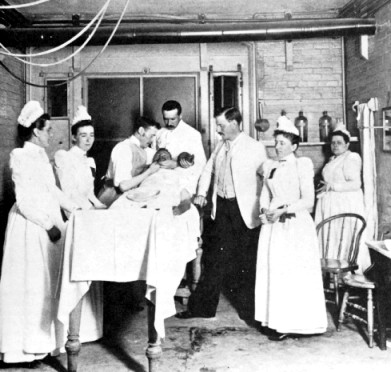Canadian National Railways - Part 1
Growing up in Montreal : First impressions are important
Except for a brief period in Schreiber, I have never lived more than a
few blocks from the Canadian National, Montreal to Toronto mainline.
As a kid who read Trains magazine, I puzzled over the US having
hundreds of railroads running here and there in a confusing, seemingly
random pattern. I was proud that in Canada we had "only" two large prosperous railways -
both of them running from sea to sea to strengthen the whole country.
To compare my childhood impressions of them :
The CPR was a cheap, unfriendly, maroon-coloured railway - always "over
there somewhere" - which even used chain link fence at Angus Shops to
prevent exploration of its retired steam locomotives.
The CNR was a proud, friendly, green and gold and black railway. It ran steam
excursions, had a Museum Train, and didn't guard its retired steam
locomotives at all.
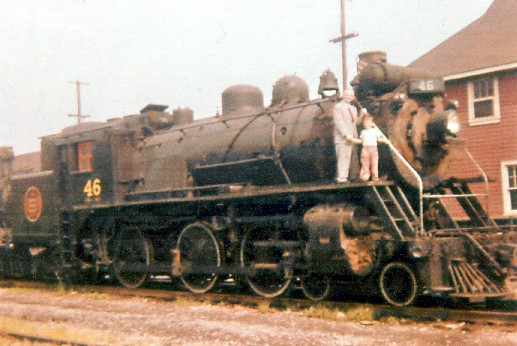 At CNR Turcot Yard in the summer of 1961 - photo by LC Gagnon.
At CNR Turcot Yard in the summer of 1961 - photo by LC Gagnon.
At the main Montreal freight yard of the former Grand Trunk,
my grandfather (a retired school principal) and I stand on the running board of a retired CNR commuter tank engine.
The locomotive was built in 1914 by the Montreal Locomotive Works for use on the Grand Trunk's Montreal west island commuter runs.
Note : Trespassing on railway property is illegal and extremely dangerous and this should never be done by anyone !
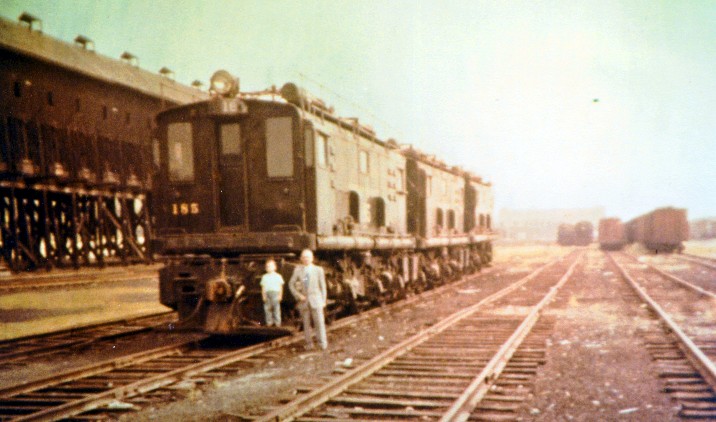 During another visit to Turcot in 1961 - another photograph by my father.
During another visit to Turcot in 1961 - another photograph by my father.
These retired English Electric locomotives were built for the National Harbours Board 1924-26,
and then obtained for use on Canadian National's extended catenary radiating from CNR's Central Station.
They smokelessly pulled trains through Mount Royal, and to other nearby urban locations including Turcot.
I suspect those pictured were destined to be used for parts to keep the other English Electric locomotives in service.
For this webpage, they symbolize very similar locomotives purchased by Mackenzie and Mann for use through their
Canadian Northern Railway's
Mount Royal Tunnel ... which provided CNoR's
transcontinental (coming through Toronto and Ottawa) north-end access
to downtown Montreal.
At the left is the Turcot Yard steam locomotive coaling tower.
The former Grand Trunk roundhouse and its many smoke stacks appear in the distance behind the electrics.
All that remains today from this photo is the rectangular building on the horizon behind the roundhouse.
During the Centennial of Canadian Confederation celebrations in 1967 - aka Canada's 100th birthday -
there was no doubt in my mind that the exciting "orange black and
white" Canadian National ... with its new CN logo, fast passenger
trains, and preserved excursion steam engines ... represented the best
of Canada from sea to sea.
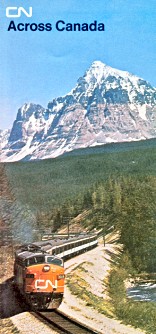 So, briefly, that was the Canadian National Railways I knew.
So, briefly, that was the Canadian National Railways I knew.
What caused the CNR to be formed ... and what was Canada like back then ?
Aspects of life in Canada - 1890 to 1910
Starting with a key political leader ... and then jumping all over the place ...
After Sir John A. Macdonald's death in office in1891, there was a
period of leadership turbulence as the parties reorganized themselves.
Liberal leader Edward Blake had chosen 46 year old Wilfrid Laurier to
follow him as leader in 1887. Liberal Laurier is probably familiar to
many for later saying :
"The nineteenth century was the century of the United States ; the twentieth
century will be the century of Canada."
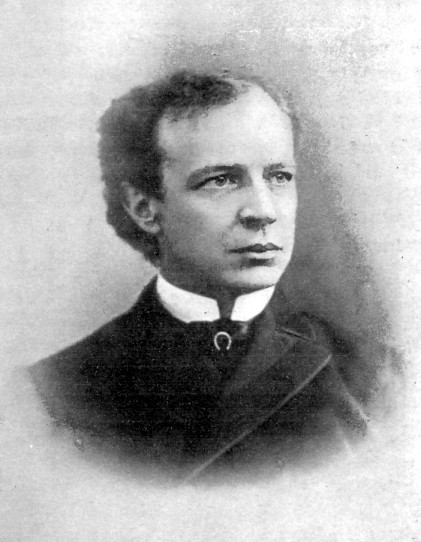 Laurier in 1887 when he became Liberal leader.
Laurier in 1887 when he became Liberal leader.
In Canada health plans consisted of "pay as you get treated" plans or
charity - mainly from religious institutions. Compared to today,
treatments were pretty limited. To give a quick example: being wealthy was
no guarantee of a woman surviving childbirth if things didn't go well.
Living without effective family planning ... often with large families
to care for - but without electrical home appliances to automate the
work ... and not having equal standing with men
in society, such as the right to vote ... the era's limits on the participation of women ... seem
foolishly detrimental to Canadian society when considered today.
Montreal operating room 1892
Obviously with a lot of time on my hands ... I sometimes try to guess
what a society would remember ... which big events happened 20, 30, 40
years previously ...
For example ... do you know "Baby Boom age people" today with fond - and endlessly
repeated - memories of the Beatles, President Kennedy and Expo 67 ?
-
During the 1890-1910 era, Canadians with similarly recent memories would think of the US Civil War ... with over 500,000 dead from battle
or infection. Also fresh in some memories would be Washington's retaliatory threats
to British North America after Britain declared support for the
Confederate side.
- Later there were numerous cross-border raids by Fenian
"terrorists" into Canada - the result of other British Empire baggage.
- A final less grim memory of 1890-1910 "Baby Boom age people"
would be oil wells in Ontario ... which were at their prime long before Alberta and
Saskatchewan became provinces in 1905.
Around 1900, businesses maintained stables of horses for the urban delivery of
goods. When companies added up the "value of their assets" for their
annual balance sheet calculations ... rather than using "acquisition
cost less depreciation" for their horses ... businessmen were advised
to have fiscal year end appraisals done of their horse "fleets" ... and
to enter that number for the "asset value".
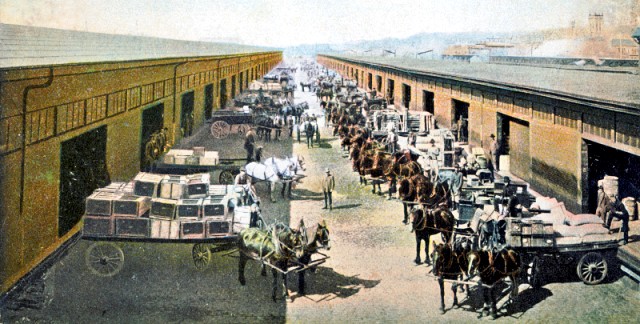 Teams and teamsters at the Grand Trunk freight sheds, Bonaventure Station, Montreal.
Teams and teamsters at the Grand Trunk freight sheds, Bonaventure Station, Montreal.
Steam railways and steam ships were used for longer distances. A variety of shallow draft steamboat routes were still in
existence on inland waters. Lumber was often rafted down major rivers.
Space heating and industrial energy came mainly from coal, with
wood for space heating in rural areas. Hydro-electricity was starting to
become important for urban and local industrial use. There was some
"natural gas" piped within
cities from local coal gas extraction plants. Kerosene would have been
a common and dependable source of light, refined from Ontario, Pennsylvania and Texas oil wells. Gasoline was not in common use.
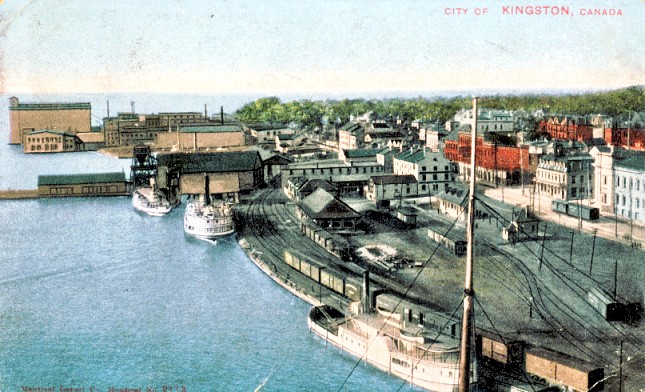 Kingston, Ontario circa 1900. Taken from a grain elevator with a ship's mast in the foreground.
Kingston, Ontario circa 1900. Taken from a grain elevator with a ship's mast in the foreground.
The Grand Trunk spur runs along the waterfront to the Grand Trunk "inner station" and ...
to the Canadian Locomotive Works : the dark coloured complex and its attached buildings in front of the distant grain elevator at the horizon.
The Kingston and Pembroke, a CPR subsidiary, veers off to its station behind the mast.
Note the shallow draft steamboats.
Christian religion played a significant part in the lives of most
Canadians. Before compulsory education was universal ... and where child labour was common ... the Bible and
other Christian literature might be the only contact many would have
with books. Bible stories, Bible passages, hymns and other
aspects of Christian liturgy, would be common references within a local society
... sort of like American TV shows, movies and music are today.
"I'll be baaack" ... probably had a different cultural meaning back then
with the Good Samaritan story in common circulation.
Orangemen, Catholics and other ethno-religious communities often
scrapped over
power, control - and even basic rights - in society and government. To
make matters worse,
relations between citizens also frayed across the jagged English-French
linguistic divide. Around this time, minority education rights were a
favourite bone of contention with little political credit for any
politician who dared address them.
As Conservative Macdonald's spiritual successor in strengthening
Canadian unity through careful politics, Liberal Laurier often lost political support as he
dealt with religious and linguistic controversies.
 Spring 1897 in the House of Commons of the original Parliament Buildings
Spring 1897 in the House of Commons of the original Parliament Buildings
... later destroyed during the 1916 fire.
At this point, Laurier's first government has been in power for almost a year.
Clifford Sifton was Laurier's minster of
the interior and Indian affairs from 1896 to 1905. He is well known for
his insights into the federal government's potential role to stimulate
the economy and he dabbled in railway policy as well. He put systems in place to encourage British, American, and eastern European immigration ... primarily for the
purpose of populating the Canadian interior. Naturally, the federal,
provincial, and municipal governments helped stimulate all of this activity by
supporting railway construction.
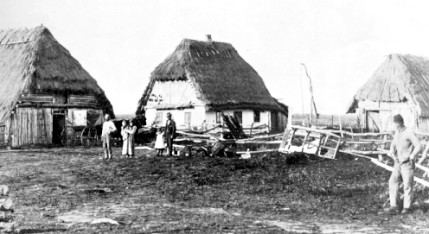
Sifton's "stalwart peasants in sheep-skin coats" in this photo are Galician settlers in Manitoba in 1913.
Galicia overlapped today's south-east Poland and the western Ukraine.
Overpopulation, ethnic conflicts ... and railway and government advertising abroad ...
caused many to seek a better future in Canada's west.
Showing some of the effects of Macdonald and Laurier-Sifton railway and immigration policies,
here is Canada's population ...
Province
|
1911
|
1901
|
1891
|
1881
|
1871
|
Nova Scotia
|
492,338
|
459,574
|
450,396
|
440,572
|
387,800
|
Prince Edward Island
|
93,728
|
103,259
|
109,078
|
108,891
|
94,021
|
New Brunswick
|
351,889
|
331,120
|
321,263
|
321,233
|
285,594
|
Quebec
|
2,003,232
|
1,648,898
|
1,488,535
|
1,359,027
|
1,191,516
|
Ontario
|
2,523,274
|
2,182,947
|
2,114,321
|
1,926,922
|
1,620,851
|
Manitoba
|
455,614
|
255,211
|
152,506
|
62,260
|
25,228
|
Saskatchewan (1905)
|
492,432
|
91,279
|
|
|
|
Alberta (1905)
|
374,663
|
73,022
|
|
|
|
British Columbia
|
392,480
|
178,657
|
98,173
|
49,459
|
36,247
|
The GTR
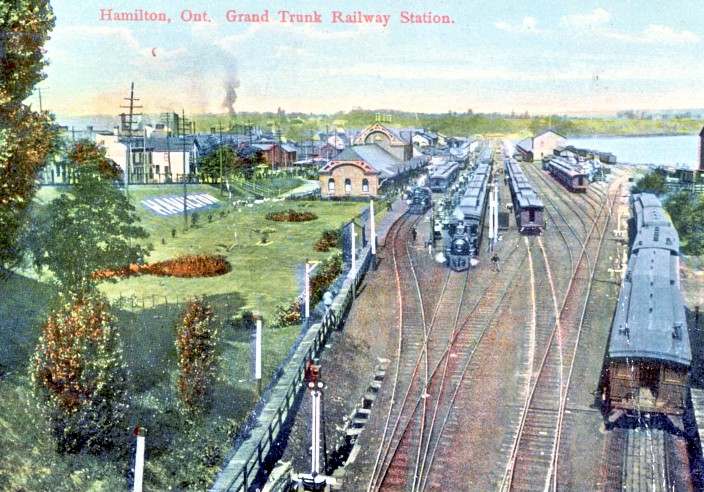 One of Canada's early railways - 30 years before the completed CPR - was the Grand Trunk.
One of Canada's early railways - 30 years before the completed CPR - was the Grand Trunk.
The equipment shown suggests the 1890 era or earlier (to me).
The GTR was built mainly with British capital and run by a board of directors in England.
The
fact that it was "foreign" with US subsidiaries connecting westward to
Chicago, and east to its Portland, Maine seaport terminus ...
proved to be a significant political liability when Prime Minister Robert Borden came on the scene.
Ahhhh !
I see Robert Borden has just arrived.
Sir Charles Tupper wanted a new face to lead the Conservative party
and he suggested to the startled and disbelieving Borden that he should take the job himself.
... and he did - in early 1901.
For Borden, "serving" in government was a duty which he felt successful citizens had.
Unlike many politicians, he did not enjoy just listening to the sound of his own voice ...
and he found the Parliamentary parry and thrust ... and speeches generally ... stressful.
A successful lawyer from Halifax, he was Prime Minister of Canada after Laurier ... from 1911 to 1920.
If you are a Grand Trunk Railway shareholder ...
NOW is the best time to calmly place a "market order" to dump your stock !
It's you he's looking at !
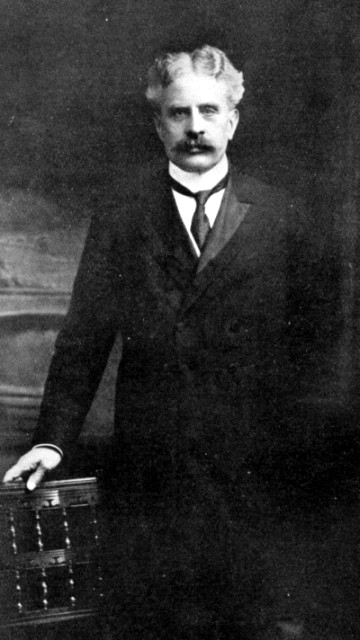
Robert Borden circa 1912
(He is probably hiding a spray can of Shareholder Whupass in his left hand)
As opposition leader in 1903 he said, foreshadowingly :
"Shall we have a Government owned railway, or, a railway owned government?
If the people undertake nine-tenths of the obligations, why not the whole, and own the railway?"
The table below helps show the long careers of ... Canada's Greatest Railway Prime Ministers After Macdonald
... a new reality show coming soon to CBC-TV !
- Today, hired professional political operatives ... and party
infighting ... quickly incinerate big party leaders who fail to quickly grasp
and keep power for the party.
- Notice how long these two were allowed to lead their respective
parties without winning. I know we were involved in one Imperial skirmish and one big war during the period
... but still ...
- Bold type indicates who was prime minister after the election in a particular year.
- In 1918 it was decided that Britain would not confer honours
(e.g. knighthoods) on Canadians without the Canadian Prime Minister's
approval and advice - not including military distinctions.
Laurier and Borden across the aisle in Parliament
Election
|
Liberal Leader
|
Conservative Leader
|
1891
|
Wilfrid Laurier 5 years in opposition
|
|
1896
|
Wilfrid Laurier |
|
1900
|
Sir Wilfrid Laurier |
Election lost. Then Borden new leader 3 years in opposition
|
1904
|
Sir Wilfrid Laurier |
Robert Borden 4 years in opposition
|
1908
|
Sir Wilfrid Laurier
|
Robert Borden 3 years in opposition
|
1911
|
Sir Wilfrid Laurier 6 years in opposition
|
Robert Borden |
1917
|
Sir Wilfrid Laurier 2 years in opposition
|
Sir Robert Borden - last PM knighted in 1914
Knighted 2 months before WW1 began.
"Unionist government" - i.e. included defecting Liberals
|
End
|
Died 1919
|
Retired 1920
|
Laurier and the Grand Trunk Pacific
Charles Melville Hays was an American railroad manager who was invited
to Canada by the Grand Trunk in 1895 to serve as its general manager.
He was promoted to president in 1909 and died on the Titanic's first
voyage in 1912.
He made a number of improvements to the GTR's physical plant and
equipment, such as double tracking the Montreal to Toronto mainline - today used by CN and VIA.
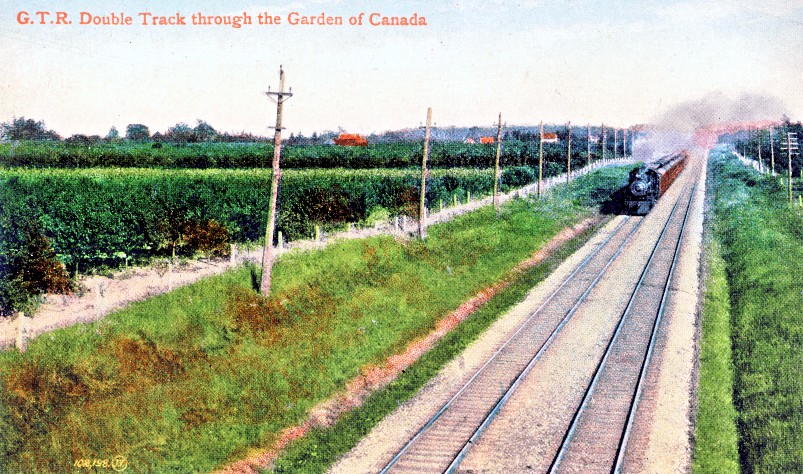 Well-maintained Grand Trunk mainlines.
Well-maintained Grand Trunk mainlines.
Seeing Laurier's and Sifton's efforts to encourage Canada's growth
on
the prairies, Hays believed the GTR should expand to the Canadian west
... by travelling
SOUTH around the Great Lakes through Chicago. He quit in a snit for a
US job, when this plan was turned down by the British directors ...
until the US job didn't turn out the way he expected and he quit there
too.
Meanwhile, Laurier was pushing for an east-west competitor to offset the Bank of Montreal-Conservative characteristics of the incumbent
transcontinental - the CPR.
Perhaps he could convince the GTR ... and Mackenzie and
Mann's prairie "farmer's railway" - the Canadian Northern ... to merge ...
... or not ...
- It would be highly improbable for a British-owned In-sti-tyu-tion to cooperate with a couple of CPR contractors who grade
their dirt roadbeds with farm equipment ... mere tradesmen, what?
- On the other side, Mackenzie and Mann were far too ambitious to just sell
out to Fuddie-Duddies ... who couldn't gird the country with steel and make a fortune ... as they had.
Laurier's possible desire to have a Laurier-Liberal-transcontinental-railway for
his regime
... to match Macdonald's CPR "monument" ...
led to the
mutually convenient outcome of working with Hays.
The latter was back
again at the GTR at his old job and still enthusiastic.
West of Winnipeg, it would be a GTR subsidiary which would be built and operated by the GTR - The Grand Trunk Pacific Railway.
East of Winnipeg, the
government would build the line for the GTR to operate. Eastern
Canadian ports such as Quebec City - perhaps Saint John - could handle
export grain rather than having it go to GTR's Portland, Maine and
other US ports. After all, why shouldn't Canadians have their own seaport jobs and
economic development from their own grain?
"Let's call it the eastern part the National Transcontinental Railway - that'll be swell !"
"We'll find a place to put it ... somewhere ... um ... in northern Ontario and Quebec" [Laurier's political stronghold]
"It'll open up new settlement and we'll probably find gold and get rich ! Yahooo ! "
The GTR's luck in
running profitable railways "by telegraph" from far away England is going to improve - can't you just feel it ?
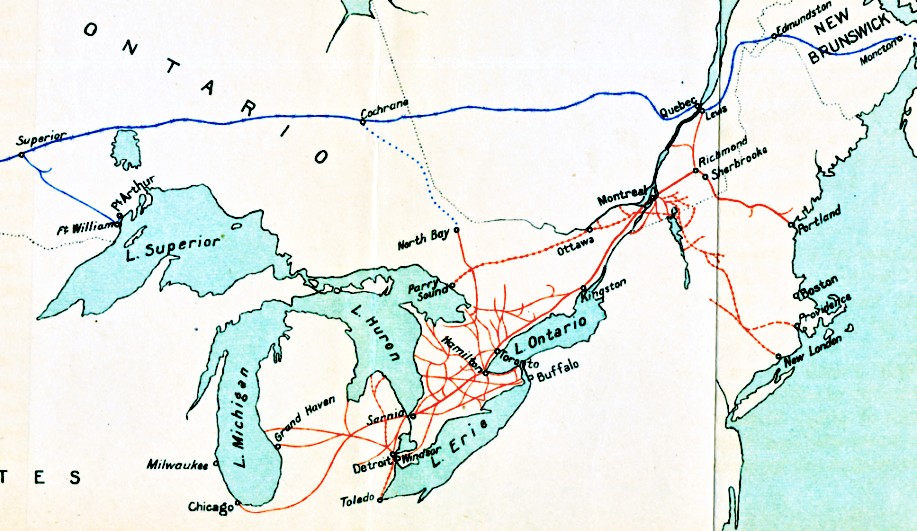 This map shows the Grand Trunk system as it existed in 1914.
This map shows the Grand Trunk system as it existed in 1914.
GTR's 1895 network is represented by the solid red lines ... while other red lines indicate new acquisitions or construction.
The
blue shows the government's National Transcontinental with its western
grain branch to Fort William (and Fort William Union Station), via Superior
Junction.
The blue dots, North Bay to Cochrane, represent running rights on the
Temiskaming and Northern Ontario Railway - part of today's Ontario
Northland Railway.
And now we return to 1903 ...
when the Grand Trunk Pacific and National Transcontinental are still in the talking legislation (!?!) stage ...
Laurier's 59 year old
Minister of Railways Andrew Blair is reacting to the surprising news of Laurier's
decision to put NTR/GTP legislation through Parliament.
Blair had been Premier of
New Brunswick ... negotiated alongside Sifton with Van Horne for the
new CPR Crowsnest Pass line ... and knew the Quebec-Ontario-US Grand Trunk had never been a
supportive friend
of the government's Intercolonial Railway to Halifax which was headquartered in his province.
The ICR was also the only all-Canadian route running to the TWO major Canadian seaports on the Atlantic.
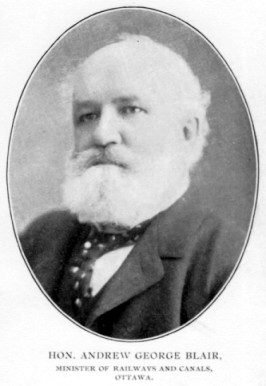 Andrew Blair circa 1902
Andrew Blair circa 1902
This emperor who kept such a tight hold on his
cabinet wasn't wearing any clothes ... but Laurier still strutted around, comfortably wrapped in this NTR/GTR idea.
His mind made up, he wouldn't listen to
Blair's opinions and cautions.
The rest of Laurier's stiffly smiling court remained silent ... perhaps with Sifton giving Sir Wilfrid a wink and a "thumbs up".
The now doomed Blair, after 7 years in Ottawa, rose
in the House
to explain his resignation to everyone else on July 16, 1903 ...
Among the most descriptive passages from Blair's long speech :
I think it becomes my duty to make a statement as the retiring minister in my own behalf.
... The only cause which has led me to take that regrettable step is
because I have been unable to justify to my mind, to my own conscience,
and to my own duty to my people, the support of the proposal which the
Government have decided upon making to this House and the asking of
legislation to pass with respect to the project known as the Grand
Trunk Pacific Railway.
... I objected to the government constructing another government road
from Levis to Moncton. I objected to it because it paralleled the
Intercolonial Railway in my opinion, without a doubt.
... Another objection was that I thought we were proceeding with
undue haste. ... I am not in favour of impetuously rushing into the
construction of a transcontinental line from Quebec, through an unknown
country to Winnipeg and the west, until we know something about it -
until we have the fullest information about it. The project is one of a
very great magnitude, and should be dealt with only after the maturest
deliberation.
He then quoted from his recent correspondence to Laurier (at this point Laurier's complexion is turning from white to grey) :
I could not bring myself to believe that a scheme so
objectionable and alarming in many respects would be finally and
deliberately adopted by government ... I think I might justly complain
that so important a matter of policy, arising within the sphere of my
own department, should have been conducted and continued in this way
behind my back and without my knowledge ...
... Let me state our position on the main question: My decided
preference is for a government owned and government operated railway
across the continent, and my chief reason for favouring it is that it
will have an equalizing and regulating influence upon all other
railways throughout the western territory. In this view I am
practically alone ...
... It will be difficult to explain why government should build and
own the lean section of this railway, and provide a company with
government credit to enable them to build and operate the fat section.
After providing several alternative policy choices, Blair concluded :
My strong conviction is that this country cannot wisely adopt and
carry into operation the policy which my right honourable friends the
government has adopted.
The tailend of Sir Wilfrid Laurier's time as Prime Minister
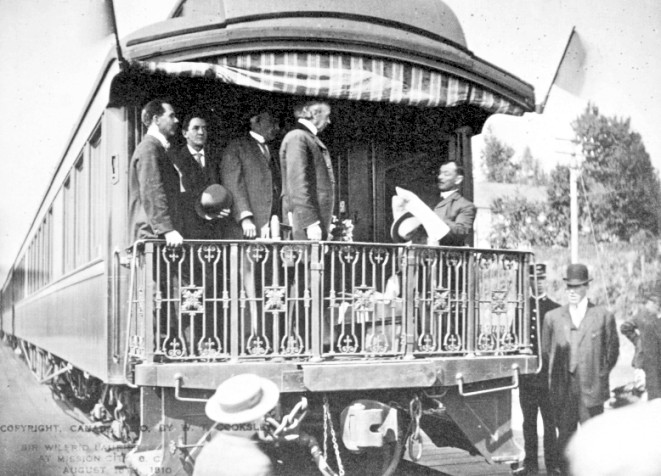
In 1910, Laurier took a pre-election swing through the west.
Here
at Mission City, British Columbia, he is receiving some feedback from a
local citizen - the car's step box is between them.
Governments defeat themselves.
The 1911 election was "about" Free Trade with the US ... or Reciprocity as they called it in the olden days : you lower your tariffs and I'll lower mine.
Laurier had also recently advocated setting up a Canadian Navy ...
You see, there was a "Dreadnought Gap" panic in Britain ! Germany seemed to have
more battleships than England and needed help !
[Equally as important as Dreadnought
Class battleships in World War I ... as it turned out ... was the fact
that Britain had fewer bulls with udders]
Is Reciprocity for you ?
Most Canadian manufacturers liked the existing time honoured "National Policy" because it shielded them from US competition using HIGH import tariffs at the Canadian border.
However, if you were "hewing wood and drawing water" (lumber, base metals, farm products, fish) getting into the US market was easier with reciprocal LOW tariffs on their side.
Imported goods would probably also be cheaper if the Canadian tariffs were lower - the Wal*Mart phenomenon.
So traditional Canadian export industries would do well ... and
their working lumberjacks, miners, farmers, fishermen and railroaders would do well =
many, many votes for Laurier !
How did the Conservatives and disloyal Liberals who wanted HIGH import tariffs defeat Laurier in the 1911 election ?
As usual, the message was different ... depending on which Canadian political silo you were shouting into :
- Laurier is French ! ... of course he wants Free Trade and closer
ties with the Americans - he hates Britain and soon the Stars and
Stripes will fly over Canada. "Canadianism or Continentalism!"
- "Sir" Laurier ! ... of course he wants a Canadian navy so he can
sail around the world with the "Royal" Navy. He is a lapdog of his
British masters. Vendu!
- You know as well as I do that we will likely lose important
manufacturing jobs, feeder industries, and Canadian businesses if
Laurier wins this election.
- Laurier runs Quebec politics by rewarding [X Y Z] who are his
friends. Look at the NTR contracts ! He and his gang are corrupt and must be thrown
out.
- L'enfer est rouge, mais le ciel est bleu.
I don't actually know if they used this way back then, but this
campaign expression was popular in Quebec where religion was a central
part of cultural identity ("ciel" could refer to both sky and heaven).
Canada's railway situation in 1915 - four years into Borden's government, and one year into World War One
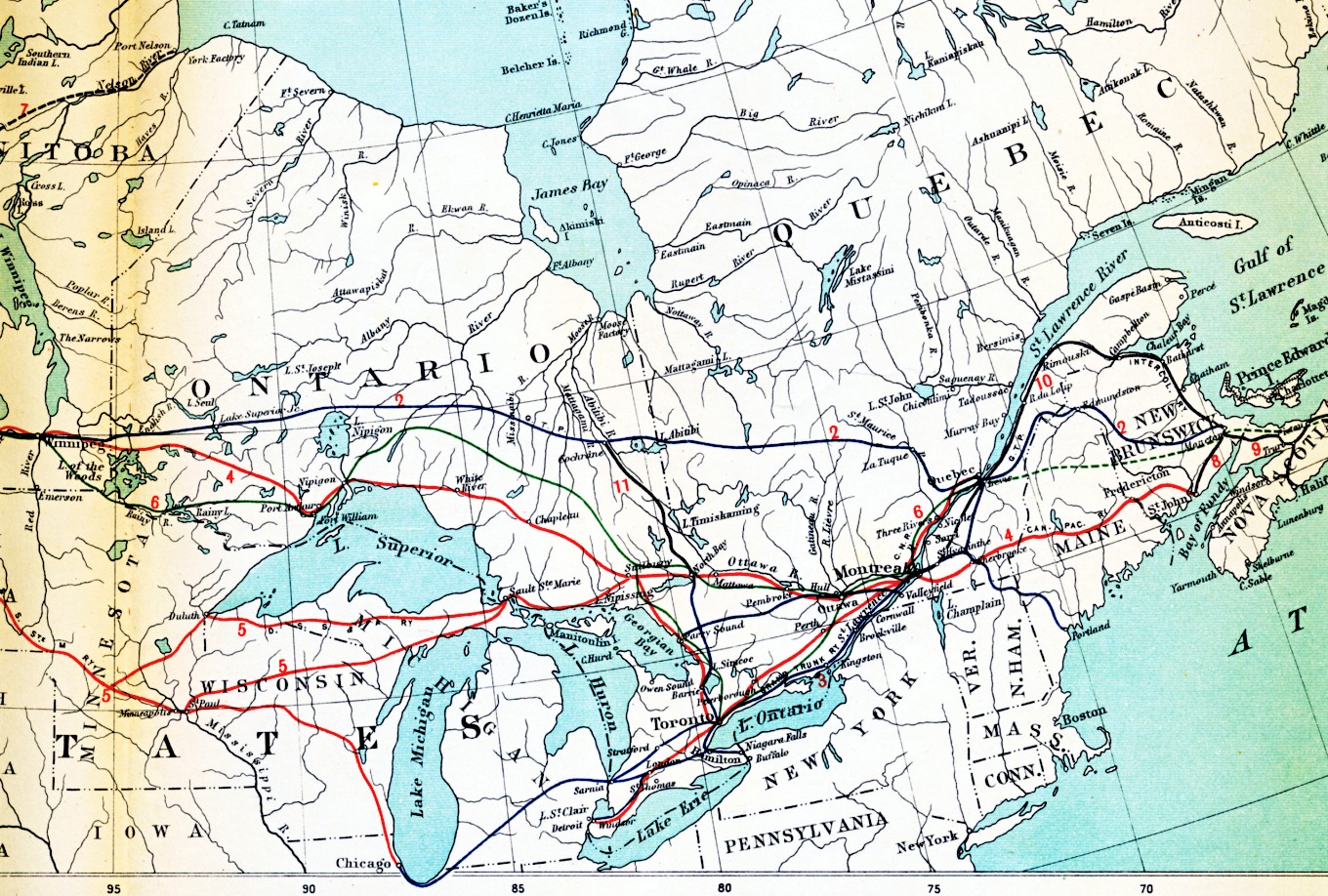 map: Canadian mainlines east of Winnipeg in 1915
map: Canadian mainlines east of Winnipeg in 1915
- NOTE: THESE ARE MAINLINES ONLY
- The Canadian Pacific system is red.
- Grand Trunk is blue
HOWEVER, Number 2 is still the Canadian Government Railways National
Transcontinental for which the Grand Trunk Pacific never assumed
responsibility.
- The good old Intercolonial (one of the Canadian Government Railways) is black and running all the way west from Halifax to Montreal.
- Canadian Northern is green.
- The US came into the world wars after Canada - maintaining its
neutrality and hopefully the safety of its Atlantic Seaboard shipping. So, at least initially, uniformed Canadian soldiers had to use the
National Transcontinental and Intercolonial to reach Atlantic troop
ships. (The CPR shortline to the Maritimes runs through Maine)
- Another interesting feature is the projected line of the Hudson
Bay Railway into Port Nelson. The line was rerouted to today's
Churchill when it became apparent that regular heavy dredging would be
needed to keep the Port Nelson harbour open.
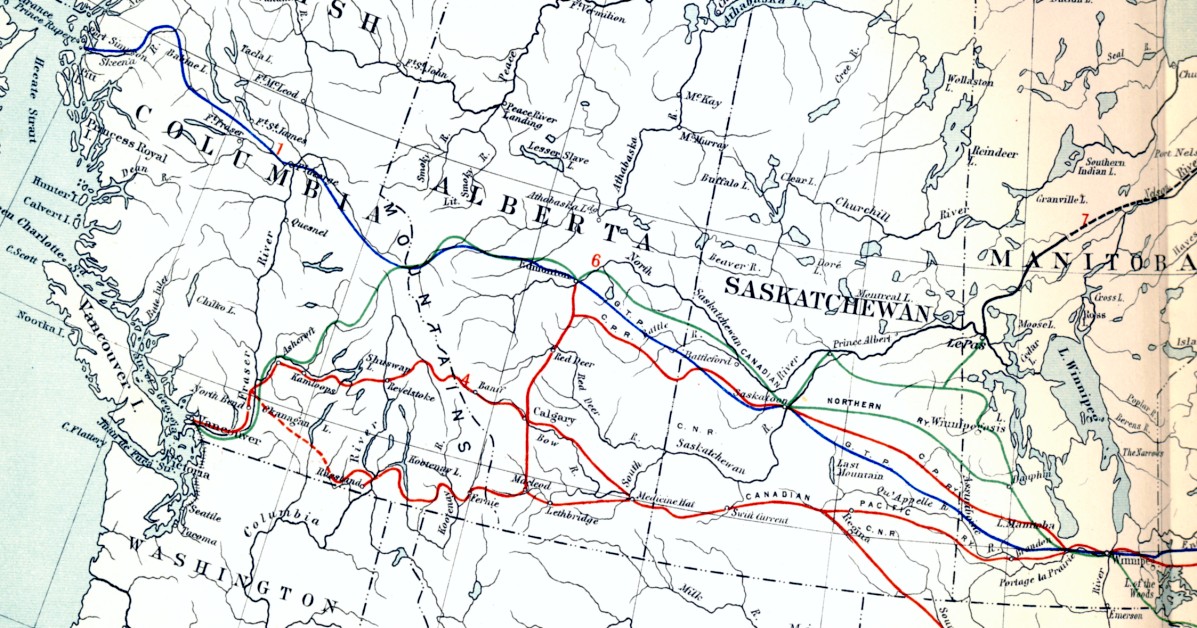
map: Canadian mainlines west of Winnipeg in 1915
- NOTE: THESE ARE MAINLINES ONLY
- The projected CPR Crowsnest Pass
route to promote Canadian control of the mining of southern BC's
mineral resources near the US border is shown east of Vancouver. The famous
"Crow Rate" for transporting western grain originated from the
government/CPR negotiation for this line.
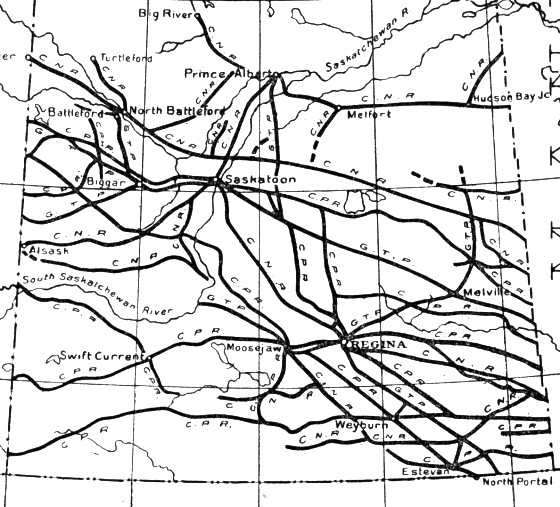 map: Saskatchewan railway lines 1919
map: Saskatchewan railway lines 1919
This government map shows the Grand Trunk Pacific still in private hands
and the Canadian Northern which had recently been taken over by the government.
This map compares nicely with the mainline map above to give you an idea of the richness of the prairie rail network.
If you were a grain farmer of the time, transporting your wheat by horse-drawn wagons on dirt roads,
you probably wouldn't want the nearest railway and grain elevator too far away.
A ten mile one-way trip was often the maximum sane people would tolerate ... see below.
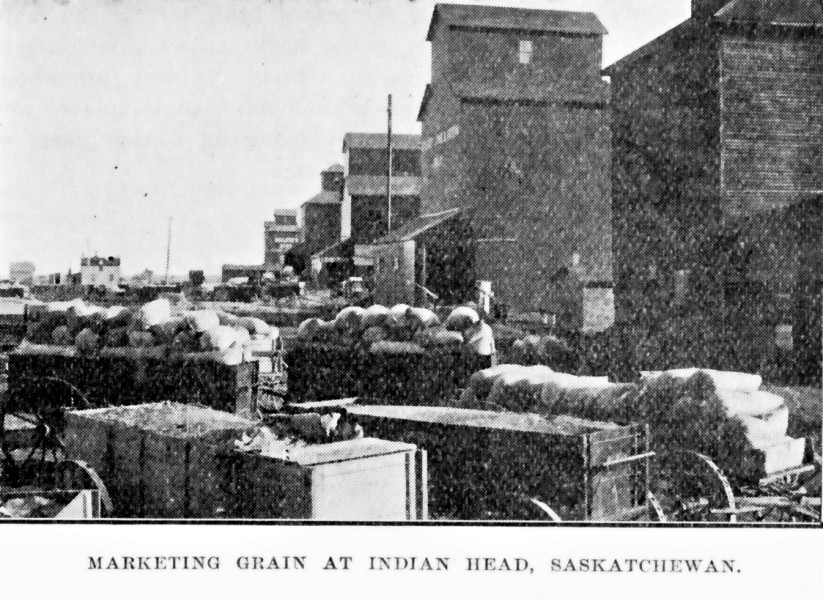 CPR grain elevators at Indian Head
CPR grain elevators at Indian Head
From a cheap 1909 CPR booklet for prospective colonists ... printed poorly on thin paper.
You can carry more on a wagon if you bag the grain, it seems ... just don't lose the load at a low spot in the road.
This is why prairie branchlines were later thought to be "overbuilt".
Note how small the elevator scale house is for the wagons.
Some of Borden's other diversions beyond Canadian Railways
1914-1920
CNR Part 2 will explore aspects of the "Canadian Railway Problem" and how it was addressed by the Borden government.
What is remarkable is the CONTEXT in which the Canadian railway
decisions were being made ...
Neither you nor I will have the patience to go through a chronicle all of Borden's activities. However, considering the many little problems which cause such national
stress and debate in Canada today ... it is interesting to contrast and
consider the tremendous stresses which affected ALL Canadians in one
way or another during this period of history.
Borden had more to worry about than ... makeovers, media relations, "great visuals", polls, and looking natural while using a tele-prompter.
Ask Borden what a "war room" was.
He was a very busy, responsible leader with growing frustration about foreign decisions
which were being made at great cost to Canada and Canadians.
He had some ideas which were unusual for a Conservative.
These factors ultimately affected how the railways were handled.
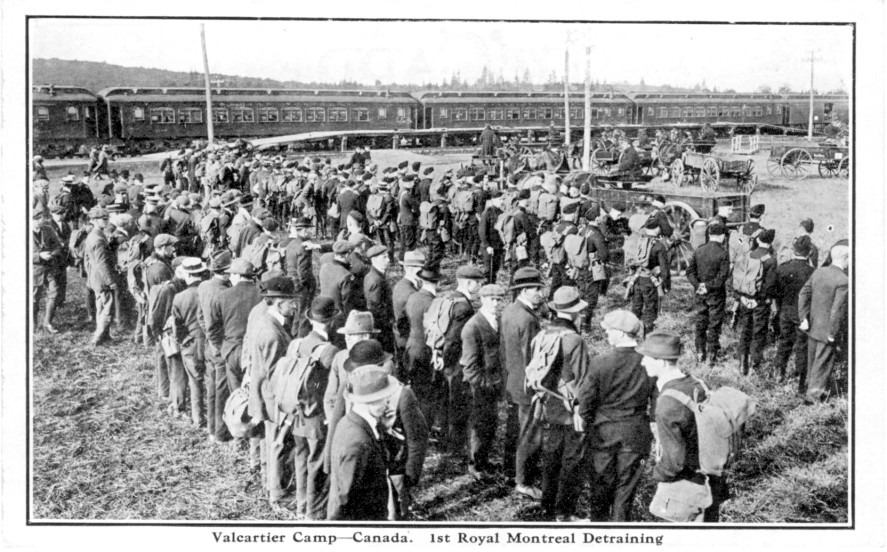 The volunteers arrive at the scratch-built training camp at Valcartier, Quebec.
The volunteers arrive at the scratch-built training camp at Valcartier, Quebec.
Canadian Northern coaches are at the platform - each train to Valcartier carried around 600 men.
Comfortably assume that at least half of the people you see will be shot, bayonetted, torn to pieces by artillery,
die of uncontrollable infections, or gassed with chlorine, phosgene or mustard gas by war's end.
Many of those who survive intact will be affected by a mysterious "new" battlefield phenomenon
which will leave them prone to depression, alcoholism, and suicide once they return to civilian life.
At the time, a common fear among the volunteers was that they would miss the war because it would be over by Christmas 1914.
By 1916, most Canadians knew better than to volunteer for this war.
Borden Government activities and various demanding events during World War One
- Passed the War Measures Act - important later in the railway story.
- Established
a fund to assist soldiers' families ... and the Canadian Expeditionary
Force saw its first action in April 1915 at Second Ypres.
- Reached peak military strength at 330,000 people in 1916 but further increases were not possible ...
- Shortages of labour affected the Canadian economy.
- Government
bond issues were floated in New York, after the London stock exchange
closed to foreign issues ... to keep capital in England.
- Borrowed successfully from the Canadian public through Victory Loans ... to the government's surprise.
- Established a more objective purchasing process for military
supplies - rather than the traditional government purchasing style of "favourite
contacts".
- Seized control of the1915 wheat crop from private grain companies and set
up the forerunner of the Canadian Wheat Board to control runaway prices charged by middlemen.
- Tossed Sam Hughes out and set up the Ministry of Overseas Military Forces
in London to better manage the Canadian military force ... which was still under
British command.
- Borden telegram to Canada's Acting High Commissioner, London, January 4, 1916 "It
can hardly be expected that we shall put 400,000 or 500,000 men in the
field and willingly accept the position of having no more voice and
receiving no more consideration than if we were toy automata ...
Procrastination, indecision, inertia, doubt, hesitation and many other
undesirable qualities have made themselves entirely too conspicuous in
this war."
- Borden telegram to Canada's Acting High Commissioner, London, February 21, 1916 " Believe
you should carefully watch movements Admiralty in requisitioning ships
when they act on advice of interested persons. Why does Admiralty not
consult us before requisitioning ships employed by Canadian Companies.
There must be either consultation or representation upon requisitioning
board." Canadian coastal and export shipping had been
disrupted significantly because the British were simply helping
themselves to Canadian ships ! The railways were forced to embargo some ports until the shipping backlog could be cleared.
- Borden himself expressed concern directly to the British government during
multiple visits to London ... about the conduct of the
war by generals without civilian oversight.
- Borden also spent a significant amount of time visiting troops, particularly those in military hospitals.
- British Prime Minister Lloyd George was desperate for more soldiers
to replace heavy losses and looked to the dominions. Borden insisted that Canada and the other dominions
must be involved in war planning. Canada was admitted to the Imperial War
Cabinet in spring 1917.
- Returning to Canada Borden pushed for Conscription in 1917
as his duty to support the wounded Canadian soldiers he knew and those
still in the trenches. This was necessary as the war was predicted to
continue until 1920. Britain was even releasing some prison inmates to
fight. Borden didn't understand Quebeckers ... and many of them didn't
understand Canada's desire for "recognition" in a foreign war declared
for them by the British Empire.
- Easter 1917 : The legendary attack and capture of Vimy Ridge by
Canadian troops ... under Currie's command with all Canadian units fighting together for
the first time.
- December 6, 1917 : The Halifax Explosion destroys the local
facilities of the Intercolonial Railway and areas of Halifax : 1600 killed ; 9000 injured ; 6000
homeless. Relief came by rail from Canada and New England.
- December 17, 1917 : After a bitter election campaign over
Conscription, on this day Borden's "Unionists" obtained a large majority in
the Commons with 114 Conservative members and 39 defecting Liberals.
Laurier won 82 seats. Given Laurier's reluctance to form a coalition
with Borden to implement conscription against the wishes of Quebeckers,
the Manitoba
Free Press had stated that "A vote for Laurier is a vote for the
Kaiser".
- Borden memorandum June 15, 1918 : "At
Passchendaele last autumn, Currie refused to fight under [British Fifth Army Commander] Gough as he
considered him incompetent [also the verdict of history] ... One could almost weep over the inability
of the War Office and even of the Admiralty to utilize the brains of a
nation at a time when brains are most needed. At the War Office they
restricted brilliant men who enlisted in the new Army to the rank of
Brigadier General in order that professional soldiers might not have
their careers interfered with. I attacked this in the [Imperial War] Cabinet on
Thursday and said it amounted to scrapping the brains of the nation at
a time when they were most needed."
- Due to Borden's persistence, Canada signed the Treaty of Versailles for itself - for better or worse.
- Borden told his wife : "Canada got nothing out of the war except recognition."
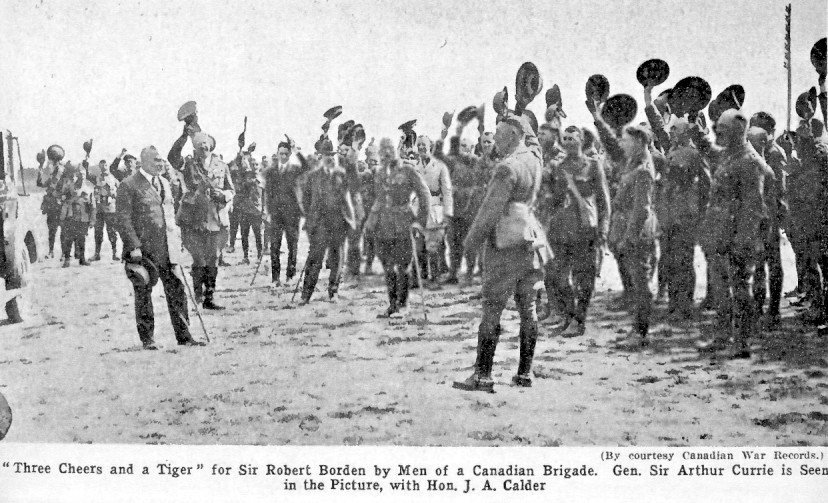 Currie is the tall "pear-shaped" officer to the right of Borden.
Currie is the tall "pear-shaped" officer to the right of Borden.
Calder (suit, hat, dark moustache) was in the Unionist government under Borden's leadership.
A Liberal from the Moose Jaw area, he is responsible for Colonization and is also on the Reconstruction Committee.
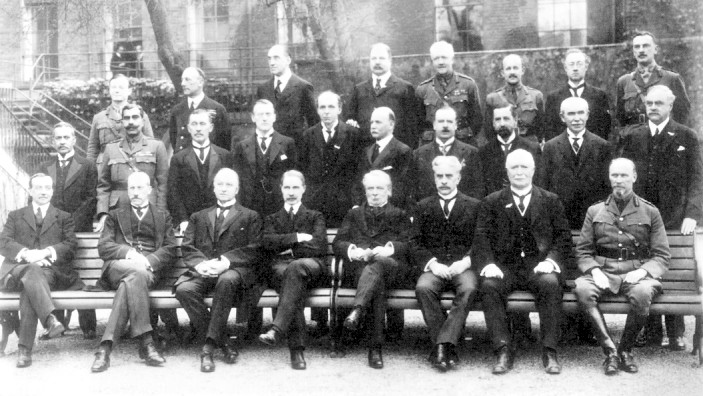 Kicking Back ... at the Imperial War Cabinet
Kicking Back ... at the Imperial War Cabinet
Front row : British Prime Minister Lloyd George fourth from right ... Robert Borden third from right.
World War One Canadian Casualties : 60,000 dead ; 150,000 wounded
Death toll of 50,000 from Spanish influenza spread to all corners of Canada by the returning troops 1918-1919.
Canadian national debt 1913 : $463 million
Canadian national debt 1918 : $2.5 billion
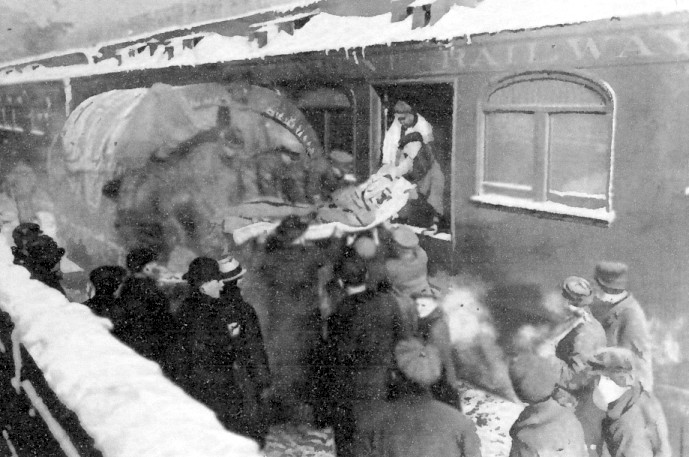 In the miserable winter conditions following the Halifax explosion of December 6, 1917
In the miserable winter conditions following the Halifax explosion of December 6, 1917
injured are evacuated on cars of the Canadian Government Railways (ICR, NTR, etc)
By this time in the war, specialized "hospital trains"
had been built to transport badly injured soldiers returning from Europe.
The cars included lengthwise bunks - to form traditional medical wards
for easier supervision and care - and assigned military medical staff.
What happens to North American railways during a world war ?
- Labour costs increase due to the labour shortage - during World
War One they doubled due to a precedent setting American railroad pay
award.
- Fuel costs increase.
- The government enforces freight rate control to prevent
"profiteering" ... but railways are still affected by economy-wide
wartime inflation.
- The government essentially requisitions the railway for scheduled
military movements ... including the transport of European gold reserves.
- Traffic levels increase as overseas demand increases for lumber,
food, fuel, steel, troops, clothing, munitions and manufactured war
equipment.
- Terminal congestion ... spikes in demand - e.g. a troop train
running in several sections to meet a troop ship ... special time
sensitive government demanded routings ... often create expensive
inefficiency which the peacetime railway system was not set up to address ... more
extra costs.
- Maintenance is deferred on the right of way and the equipment in spite of
increased wear. In World War One, Canada was proud of its overseas military
Railway Corps ... which took skilled trades, equipment and materials away
from Canadian railways.
- Railways' ability to borrow is impaired ... although there were
still plenty of US investors eager to make profits from "war
industries", the London Stock Market was closed to foreign offerings.
Before World War One, the Canadian Northern and the Grand Trunk system
were already in an expensive competition to expand themselves into transcontinental systems.
What really happened to them ?
Was Robert Borden the kind of prime minister
who would deliberately push a Railway
in front of a train ?
CNR Part 2 will explore this.
Oh, for happier times ...
 In everyone's favourite Canadian Northern photo, the engineer is working his locomotive hard at Dauphin (DOF fin) Manitoba.
In everyone's favourite Canadian Northern photo, the engineer is working his locomotive hard at Dauphin (DOF fin) Manitoba.
The rain and humidity are causing the steam exhaust to linger in
the saturated air, adding to the volume of the coal smoke plume.
The engineer is watching and listening for any slipping of his drivers.
Is it possible he just had his petcocks open four cars back - indicating the train is being restarted ?
Perhaps from a black water standpipe behind the 12th car ?
While the Grand Trunk is running fast trains on double track between Canada's small cities in the east,
this photograph (probably of grain empties)
represents the no-nonsense practicality
of Mackenzie and Mann's Canadian Northern Railway.
"Pioneer Road of the Northern Prairies"
Back to sitemap




